Sheiko Gold Best Practices
Here are some tips to get the best results possible while working with Sheiko Gold:
- Be consistent with your training: Consistency is key when it comes to making progress in powerlifting. Make sure to stick to your training schedule as closely as possible, and try not to miss any workouts.
- Use the daily readiness questionnaire: The daily readiness questionnaire is a great tool for monitoring your recovery and adjusting your training accordingly. Be honest with yourself when answering the questions, and adjust your training stress levels based on your responses.
- Log your rest days: Logging your rest days is important for monitoring your recovery and making sure you’re not overtraining. Make sure to log all your rest days, even if you don’t do any training.
- Adjust your training maxes: If you find that your training is too easy or too hard, you can adjust your training maxes on the setup page. Try increasing or decreasing your training maxes by 5% to see if that helps.
- Vary your exercises: Varying your exercises is important for preventing boredom and keeping your body guessing. Try swapping out exercises every few weeks to keep things fresh.
- Deload when necessary: Deloading is important for allowing your body to recover and preventing injury. If you find that you’re feeling run down or not making progress, try deloading for a week or two.
- Get enough sleep and nutrition: Sleep and nutrition are both important for recovery and making progress in powerlifting. Make sure you’re getting enough sleep and eating a balanced diet to support your training.
By following these tips and making adjustments as necessary, you can get the best results possible while working with Sheiko Gold.
QUICK LINKS
Key Performance Indicators (KPIs)
Selecting a training period/focus
Frequently Asked Questions (FAQs)
Just installed Sheiko Gold? Do this first.
- Start a Freestyle workout and log your first training day. Simply log what you’d normally do. This will give you a chance to try out the app with no obligations.
- Before your first AI workout, quickly review your setting around the app to ensure the AI is working with the correct info.
- Check your exercise lists and disable any you want to skip (Exercises tab)
- Disable any muscle groups that you want to skip or rest (Setup tab)
- Want a classic Sheiko experience like the templates? Set a competition date for 16 weeks from now. Switch your Prep 2 length to 12 weeks (Setup tab). Tap the coach avatar and switch to the Push Me mode (Dashboard).
- If you’re looking for something a little different, feel free to try one of the powerbuilding options in Prep 0 (full body or PPL).
- Have more questions? Try the Facebook group. Questions are typically answered promptly.
Verify Your Exercise Lists
From your main dashboard screen, tap Exercises (dumbbell icon on the bottom navigation bar) and go through your folders. Exercises are grouped into folders depending on their intent. Basic Exercises train the movement and Additional Exercises train the muscles. If you don’t have chains, for example, swipe left on an the and remove it from your active list.
You can reactivate it at any time should you change your mind.
Enable/Disable Muscle Groups
Tap on the Setup icon and verify your details. Scroll down and check your muscle group tags. If your shoulders are hurting right now, for example, you can toggle them off and you won’t be assigned any Additional Exercises from your shoulders folder.
Set a competition date if you want to get stronger
Even if you are not competing this will help the AI progress your volume and intensity over time. Set a date 3-4 months into the future. You’ll start off in Prep 1 working on your technique and finish up with a Comp Deload and taper to the test. Might as well do a mock meet and test your strength at the end, right?
Need a bit of extra muscle?
Who doesn’t? Try some off-season training. Sheiko Gold has two options for you and they both work great.
- Prep 0 (full body): use this if you prioritize strength over muscle
- Prep 0 (PPL): use this if you prioritize muscle over strength
Ready to lift?
The AI doesn’t really know you yet. It’s got an idea based on your initial response and population averages so you could technically start AI-based training right now. But you deserve the best. And to get the best you’ll need to train the AI before it can train you. The simplest way to do that is just to open up a Freestyle workout, do your normal thing, and log it as you go. As the AI gets to know you, you get to know Sheiko Gold. After 30 days the AI will be 100% ready to take over your daily training.

Or, if you really want to start today, ask for a Sheiko AI Workout and go for it. That works too.
Keep in mind that Sheiko Gold is meant to be your real-time coach. So it works best to use the app in real-time as you go.
Doing Your first Freestyle Workout
- Answer the pre-workout readiness questions.
- Add your first exercise.
- Add sets one by one as you do them under the Warmup heading until you get to your working weight range.
- Start adding sets under the Worksets heading one by one and use the rest timer to regulate your rest intervals. During your rest interval, rate the level of effort you needed to complete the prior set.
- Repeat this process for each exercise in your workout.
- Save when finished.
- Review your work done and give yourself a rating on any Competition or Basic Exercises you used.
Quick Overview of Sheiko Gold
Getting stronger generally requires that we have some form of progression. One frequently used form of progression is training load. Here’s how that looks and then how Sheiko Gold does it differently. First, the classic approach:
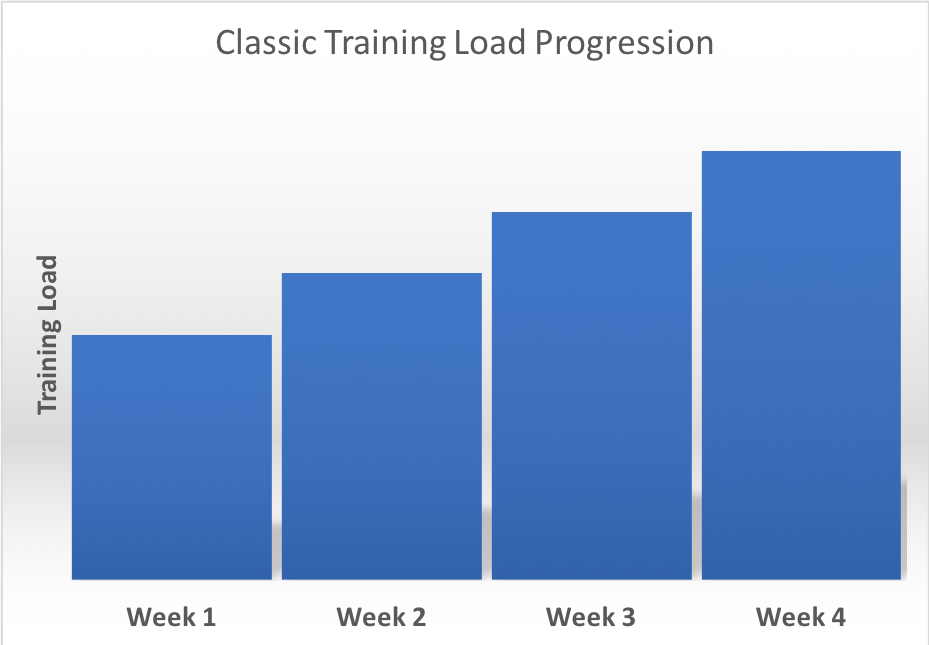
- Week 1 – Recovery Level
- Weeks 2 & 3 – Slightly below & above maintenance levels
- Week 4 – Stimulating level
Stimulating loads are the primary driver of progress. Stimulating loads are the key but we can’t do that all the time. So we also incorporate easy and medium loading for recovery and maintenance, respectively. (Author’s note: sometimes Week 1 is shown after Week 4 and called a “deload” week. That’s still the case here when these blocks are run consecutively.)
Let’s look at the daily view. Training days are Monday, Wednesday, Friday, and Saturday, as shown below. Gaps are days off.
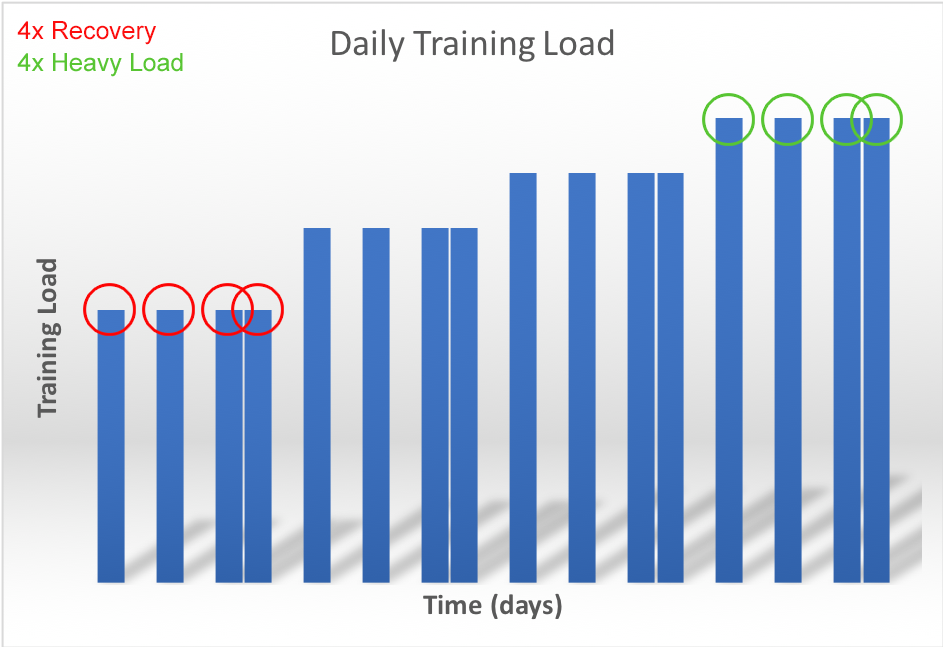
This sequential 4-week training block produces 4 stimulating days (circled in green) while also allowing for 4 recovery days (circled in red). Maintenance days here are a little excessive as it’s been shown that even very low loading is sufficient for maintenance. That said, everything seems to be in order as all the necessary elements are present.
Changing gears, let’s look at the underlying foundation of training: daily wellness. This is your daily life:

Daily wellness is a composite score of various health biomarkers (e.g. sleep quality, soreness, motivation, etc.). This score fluctuates from day to day but is typically confined to a normal range. We call this phenomenon homeostasis.
Despite days more or less being the same overall, some days you feel a bit more stressed than others. Energy and motivation can vary. Some days you didn’t sleep or eat as well as you’d have liked. And some days you just feel a bit beat up from hard work the previous day. All these daily fluctuations generally center around an average (dotted red line) but some days are clearly better than others.
How classical training fails
The problem with the classical training block shown above is the misalignment of readiness and scheduled workload. You get rest days when you’re in great shape and peak stress days when you should be resting. The classical approach can work but is not optimal or even intelligent. It will also completely fail if wellness is not stable over time and trends downwards. For example, suppose classical progression takes place when dealing with some significant life stressor outside of training (e.g. work or relationships). Wellness trends down but training stress is on a schedule to increase. Disaster can result. You can get away with misalignment for a short time but it will catch you eventually.
How optimized training is a long-term solution
When you have a real coach managing your daily training, your daily readiness is part of the program and you get something like the following. It looks complicated and messy but the idea is simple. Do harder work when ready and easier work when you need it.
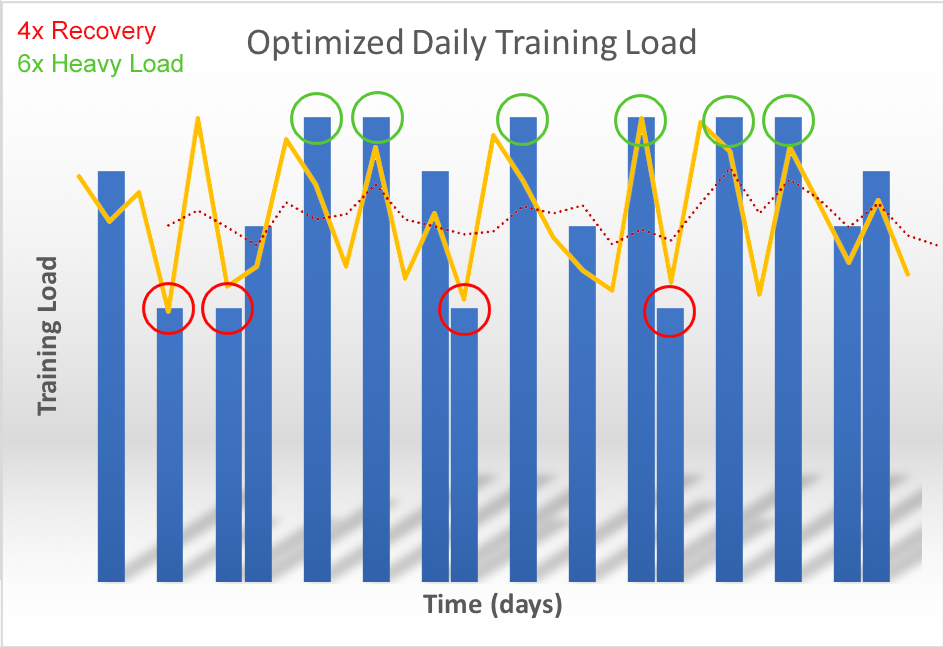
This is what an optimized training program looks like. Count the green circles here. Do you see six? Notice that optimized load results in more heavy training days over the cycle. This is technically more complicated to manage than classical training but is absolutely trivial when you hold a powerful computing device in your hand ready to process the data.
The increase in stimulating days (4 for classical vs ~6 for optimized) means more progress in the long run and staying healthy in the process. This simple plan is how Boris Sheiko tallied up 117 gold, silver, and bronze at international events. It’s not magic. It’s just common sense training you’d get from a dedicated coach.
Enough theory. Let’s see the data.
App usage data lets us examine what training with and without Sheiko Gold looks like. For 30 days you train your way (Freestyle). After 30 days, Sheiko Gold determines your training. Let’s see how they stack up against each other. (Note: this data was compiled before the addition of the fast-tracked observation period mentioned above. At this time, users we only permitted to input their own workouts instead of having the option to get a hybrid AI workout.)

People wind up doing more work and putting more effort into their training, as predicted.
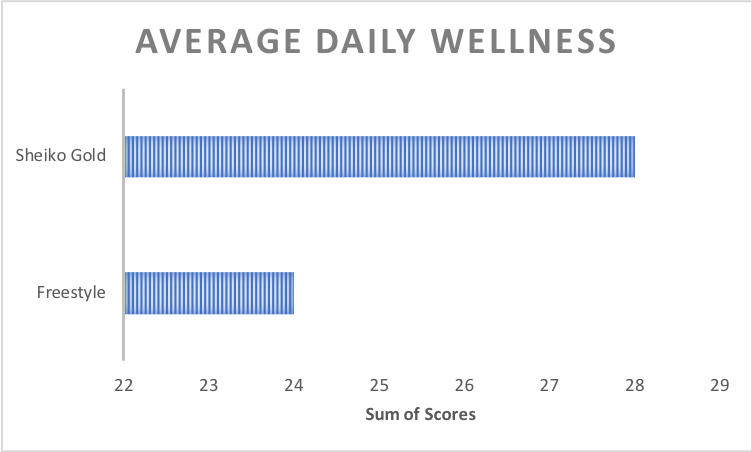
At the same time, people are feeling better and more ready to train, as predicted. (Personal note: I was still shocked to see this anyway. I’m glad you guys are doing well.)

Also noteworthy is that people are reporting improved workout satisfaction, an often overlooked aspect of training. Greater satisfaction can lead to greater effort expended in training. So this could also be a driver of improved results.
Testing Your Maxes
You can test your maxes as needed during both preparation periods. There are a few ways you can approach doing your testing. Max tests are usually spaced 6-8 weeks apart and used only if needed. How do you know? If the app is frequently increasing your weights during workouts for your competition lift and its variations, you probably need to retest your max on that lift. If it’s been at least six weeks since your last test, go ahead and start your deload by asking the app for deloads when filling out your
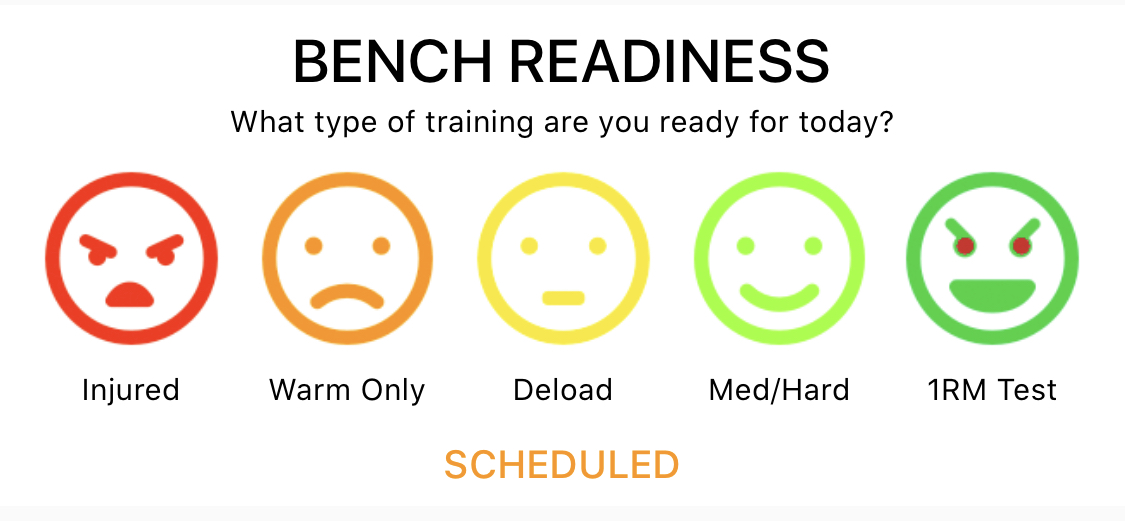
After a

If you want to retest multiple lifts, here are four ways you can arrange the tests over a few days.
| Option | Squat | Bench | Deadlift | Used |
| 1 | Day 1 | Day 1 | Day 1 | Rarely |
| 2 | Day 1 | Day 2 | Day 3 | Rarely |
| 3 | Day 1 | Day 1 | Day 2 | Very Often |
| 4 | Day 1 | Day 2 | Day 2 | Less Often |
Manually Inflating Maxes
You’re probably going to find your strength increasing. Since your workouts are based on your 1RM inputs, you’ll find the workouts getting easier as you go. Normally, you’d restest your maxes and that solves the problem. However, testing your maxes is a bit tedious at times. Testing does involve some risk as you’re exposed to maximum weights. You’ll also need to deload a few days before your tests, and after them too. All in all, it can be disruptive to the flow of training. So one thing you can do is manually add 5% to your maxes when training days start getting consistently easy.